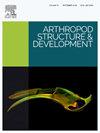Ultrastructural and light/dark adaptational characteristics of the compound eyes in the fall armyworm, Spodoptera frugiperda (Lepidoptera: Noctuidae)
IF 1.3
3区 农林科学
Q2 ENTOMOLOGY
引用次数: 0
Abstract
The fall armyworm, Spodoptera frugiperda, is a highly destructive agricultural pest native to the Americas, becoming a major invasive species worldwide over the past decade. In this study, the ultrastructure of the compound eyes and light/dark adaptational changes in S. frugiperda were investigated using light and transmission as well as scanning electron microscopy. The compound eyes of S. frugiperda are of the superposition type, featuring a clear zone. Each ommatidium contains eight retinula cells, seven of which extend through the clear zone to the basal lamina, while one cell is located near the basal lamina. The clear zone is longer in dark-adapted eyes than in light-adapted eyes. In dark-adapted eyes, the rhabdoms extend through the clear zone, with their distal ends connecting to the crystalline cones. In light-adapted eyes, however, the rhabdoms do not reach the distal region of the clear zone but are instead confined to the proximal level of the clear zone. Although the rhabdom occupation ratio to the retinula remains constant under both light and dark adaptation, the cross-sectional area of the rhabdoms and their associated retinulae is significantly larger under dark adaptation. These ultrastructural and adaptational characteristics were discussed in the context of the moth's activity preferences, particularly its nocturnal behavior.
夜蛾(Spodoptera frugiperda)复眼超微结构及光/暗适应特征
秋粘虫(Spodoptera frugiperda)是一种原产于美洲的具有高度破坏性的农业害虫,在过去十年中成为世界范围内的主要入侵物种。本研究采用光学显微镜、透射显微镜和扫描电镜等方法研究了沙蚕复眼的超微结构和光/暗适应变化。水仙复眼为叠加型,具有明显的区。每个小网膜包含8个视网膜细胞,其中7个细胞穿过透明区延伸至基底层,1个细胞位于基底层附近。适应黑暗的眼睛的清晰区比适应光线的眼睛长。在适应黑暗的眼睛中,横纹肌延伸穿过透明区,其远端连接到晶状体。然而,在适应光的眼睛中,横纹肌不会到达透明区的远端区域,而是局限于透明区的近端水平。尽管在光照和暗适应下横纹肌占视网膜的比例保持不变,但在暗适应下横纹肌及其相关视网膜的横截面积明显增大。这些超微结构和适应性特征在蛾的活动偏好,特别是夜间行为的背景下进行了讨论。
本文章由计算机程序翻译,如有差异,请以英文原文为准。
求助全文
约1分钟内获得全文
求助全文
来源期刊
CiteScore
3.50
自引率
10.00%
发文量
54
审稿时长
60 days
期刊介绍:
Arthropod Structure & Development is a Journal of Arthropod Structural Biology, Development, and Functional Morphology; it considers manuscripts that deal with micro- and neuroanatomy, development, biomechanics, organogenesis in particular under comparative and evolutionary aspects but not merely taxonomic papers. The aim of the journal is to publish papers in the areas of functional and comparative anatomy and development, with an emphasis on the role of cellular organization in organ function. The journal will also publish papers on organogenisis, embryonic and postembryonic development, and organ or tissue regeneration and repair. Manuscripts dealing with comparative and evolutionary aspects of microanatomy and development are encouraged.

 求助内容:
求助内容: 应助结果提醒方式:
应助结果提醒方式:


